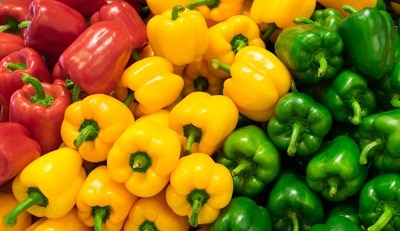One day, days ago, Senor Cargador helped me load bags of dirt from Exwork into the back of my soov (how I pronounce SUV), and then he helped me unload them in my backyard. While engaged in our well-practiced and famous Exworkian technique of levante en grupo, he asked me if we actually saved money by growing our own produce. I told him probably not, that gardening was one of my wife’s hobbies, along with arts and crafts, bible study, and feeding and cleaning up after her pets.
But later that night I started wondering about it. I had spent $384 on fifty-four bags of dirt—garden soil, cow manure compost, and peat moss. I don’t know what the moss is for. But I was happy to find that the garden soil was on sale for $2 off. I bought thirty-two of those 1.5 cubic-feet bags. I suspect I’ll be buying more.
The next day, after using the last of her frozen, home-grown peppers (I chop a lot of them into my rice and cream of chicken dish) my wife bought a bag of six green bells. I asked her how much they cost. She said five or six dollars, she wasn’t sure. I rushed back into my office, opened a new page in my little spiral notebook, clicked my #1 Grandpa pen, turned my phone on to the calculator, and got to work.
If a bag of six bell peppers cost an average of $5.50, they’re 91.6 cents apiece. Divide 384 by .916 and that means to break even she would have to grow 419 bell peppers. And we have to eat them! It doesn’t count if she lets them wither on the vine or shrivel on the counter or in the fridge, or give them away.
To be fair, she grows more than just bell peppers. She has a variety of them, from Banana to Jalapeno, and different kinds of tomatoes, Roma to Beefsteak, and onions and garlic and herbs, and little potatoes, and beans both dry and string, and even corn and berries. Those last two never do well. But the same math applies all across the raised gardens: The foods you grow must at least match the money you spend on them; you gotta break even!
And to be even more accurate, this year so far she’s also bought rolls of weed block, several small and large pots, and ten landscape logs, as well as twenty-six spikes which I use to fix the logs to the ground. I don’t know how much all that cost, but at least those things should last for a few years.
If we lived further north where the ground is dark with nutrients, she could buy packets of seeds and perhaps a little box of water-soluble fertilizer, and from maybe thirty bucks for the whole year she could harvest food worth hundreds of dollars. But down here where the land is sand, gardening is a hobby. And hobbies are usually not profitable. They are pastimes, though they can be money well spent to engage the mind. I confess I have done so with much monetary enthusiasm over the years, from tooling leather to painting with oils, and even over-charged my credit card. They were all fun at the time, but they were never profitable.
Now I have only three hobbies, or pastimes, which I call Avocation, Chores, and Compulsory. The first is writing, and I write all the time, lots of nonsense, only a fraction of which I save or send to the paper. Next is doing dishes and laundry, repairing things, and working in the yard, when I have to. Last is stepping over dog poop on the carpet and cat vomit on the wooden floor. I must admit that the necessary task of surveying the floor before I venture through the house does save me money. If I step on any of that, I will immediately throw the footwear away and buy new.
Personally, I would like to start a new hobby, storing up cans and boxes of food. That’s pretty expensive, too, but I can guarantee that I will eventually justify the cost by eating every morsel.

